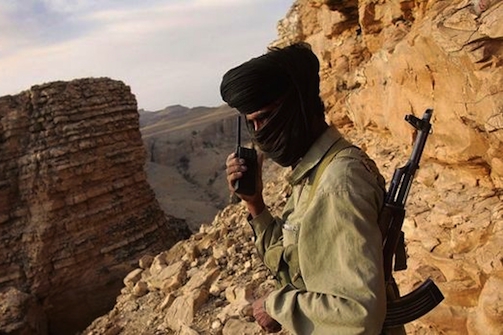 Boundary lines between Sunni Baloch extremist groups in the Sistan-Balochistan region of Iran have been difficult to identify.
Boundary lines between Sunni Baloch extremist groups in the Sistan-Balochistan region of Iran have been difficult to identify.As more operations within Iran and Pakistan are carried out, the need to identify the relationships between Sunni Baloch groups becomes more important. The current silence on behalf of Balochi groups in public forums is an effective means of drawing boundary lines. Perceived disingenuousness or competing ideologies could be reasons for the reserved behavior.�Extremist groups who made headlines in the past months include Harkat ul-Ansar (HAI) and Jaish al-Adl. The latter merged with Abdolmalek Rigi�s Sunni Balochi group, Jundallah, in 2010, after their leader�s execution by the Iranian government. The group now operates under the name Jaish al-Adl.
Harkat ul-Ansar�announced a merger�with Hizb al-Furqan in December 2013 on its webpage. Little information is available about Hizb al-Furqan prior to this merger. Even Sunni jihadist followers of the Harkat ul-Ansar have posted comments questioning Hizb al-Furqan�s identity. The two groups merged under the name Jammat Hizb al Furqan and created a website. However, most activity is through Harkat ul-Ansar�s and affiliated sites. According to an�announcement�made by Harkat ul-Ansar in December 2012, HAI also has ties with Sipah-e-Sahaba Iran (SSI), a Sunni group with links to a Pakistani group, Sipah-e-Sahaba Pakistan.
The fission and fusion of these groups creates even further pressure to identify solid boundary lines. Harkat ul-Ansar made a name for itself after taking responsibility for the July 12, 2013 suicide attack operation in Chabahar, Iran. In a video posted by the group, Abu Hafez al-Balochi, the group�s spokesman reports that the attack resulted in the death of several and 14 were injured. Despite the success of the attack, Jaish al-Adl did not release a statement of support.
On February 5, 2014 Harkat ul-Ansar presented a new look and a re-launch on Facebook. However, the group�s activity on social media platforms has been surprisingly silent, despite the rise in the Jaish al-Adl�s presence. Specifically, Jaish al-Adl posted a photo via twitter of 5 kidnaped Iranian soldiers, as well as a video of the operation to an independent Iranian news agency, Freedom Messenger. This news agency describes itself on Facebook as, �an independent Iranian news agency seeking complete change of the Iranian regime by reporting on the human rights situation in Iran, and exposing the truth [about the Iranian regime.�
Harkat ul-Ansar�s public disregard for Jaish al-Adl�s recent�claim of responsibility�for the kidnapped Iranian soldiers, makes clear that there is neither a partnership nor �friendship� between the two. What this could mean for the Sunni Balochi movements in Iran is that there are two competing factions in an already volatile region.�Although both groups share a common ideological foundation, their focus and ultimate goals differ. HAI�s spokesperson, a Baloch who has gone through formal classical Arabic training has made an appearance on Saudi al Wesal TV calling on Sunnis to support the group by sending arms. His messages are geared towards Balochis and encourage them rise up against the Iranian regime with the support of their Sunni and Wahhabi friends. If successful it could be the beginning of a new field for Jihad.
Jaish al Adl has also called on Sunnis to provide assistance but unlike HAI is not particularly drawing Sistan-Balochistan into a new jihadi field.�If HAI is successful in turning Balochistan into a new jihadi field there could be serious implications for Iran and Pakistan who are already experiencing tensions over their borders. In fact, the spill over effect would also impact Afghanistan�s Balochistan region.�The battle in Balochistan is not just about Sunni Balochi extremist groups but Sunni versus Shia Islam; metaphor for Iran versus Saudi Arabia and their struggle to preserve dominance in the region. A strong Shia Iran in the region is unacceptable to the Wahhabi state. Iran has accused Qatar and Saudi Arabia of funding and enticing Sunni Balochi groups in Iran.
Iran has not taken the proxy attacks by Saudi Arabia sitting down. It has been reported that Iran may be lending support to Yemen�s Zaidi Shias in order to counter anti-Shia al Qaeda in Yemen. Funding and support of the Zaidi Shias undermines Saudi efforts to combat Shia�ism in the region. Saudi has been closing Zaidi schools and labeling them as �extremist.� Meanwhile, Saudi has taken an interest in popularizing Wahhabi schools in the northern Zaidi heartland.�Establishing boundary lines between the Sunni Balochi groups becomes even more important as big players are involved in stirring the Sunni � Shia pot in Iran. For now, it appears that HAI is rubbing elbows closely with the Wahhabi state. For HAI, their Sunni background may be trumping its Baloch tribal roots, which means it operates under different boundary lines than Jaish al Adl.
It will be interesting to see if and at what point HAI and Jaish al Adl find it mutually beneficial to work with one another. But for now, the silence is telling.
By International Policy Digest
The Iran Project is not responsible for the content of quoted articles.











